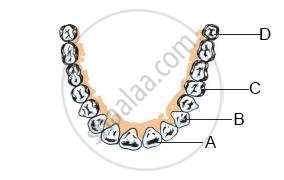Advertisements
Advertisements
प्रश्न
Label the below given Figure 2.1 as directed below in (i) to (iv) and give the name of each type of tooth.
- The cutting and biting teeth as ‘A’
- The piercing and tearing teeth as ‘B’
- The grinding and chewing teeth as ‘C’
- The grinding teeth are present only in adults as ‘D’
उत्तर

A – Incisors,
B – Canines
C – Premolars
D – Molars
APPEARS IN
संबंधित प्रश्न
List out the food items for healthy mouth and teeth.
Differentiate the following.
Diphyodont and Heterodont
Differentiate the following.
Incisors and Canines
Number of teeth present in each jaw is ______.
Match the Column I with Column II and select the correct option.
| Column I | Column II |
| i. Heterodont | a. Teeth embedded in separate sockets in jaw bone |
| ii. Diphyodont | b. Four sets of teeth |
| iii. Thecodont | c. Two sets of teeth in lifetime |
Name the four types of the permanent teeth.
Teeth are rooted in separate ______ in between the ______.
Open your mouth, look into a mirror and try to count the different types of teeth in your mouth. Compare them with Figure 2.3 on page 13 of your NCERT textbook. Record your observations in the table below:
| Type of teeth | Number of teeth | |
| In my mouth | In the figure | |
| Incisors | ||
| Canines | ||
| Premolars | ||
| Molars | ||
- Did you observe any difference in the number of teeth? If yes, could you identify which type of teeth showed the difference?
- Compare the number and type of teeth in an adult (say your parents or cousins who have reached the age of 25-30 or more). Note your observation.
Write a note on the teeth of humans.
Collect data from your friends, neighbours and classmates to know more about “milk teeth".
Tabulate your data. One way of doing it is given below:
| S.No. | Age at which first tooth fell | Age at which last tooth fel | No. of teeth lost | No. of teeth replaced |
| 1. | ||||
| 2. | ||||
| 3. | ||||
| 4. | ||||
| 5. |
Find out from at least twenty children and find the average age at which children lose the milk teeth. You may take help of your friends.
